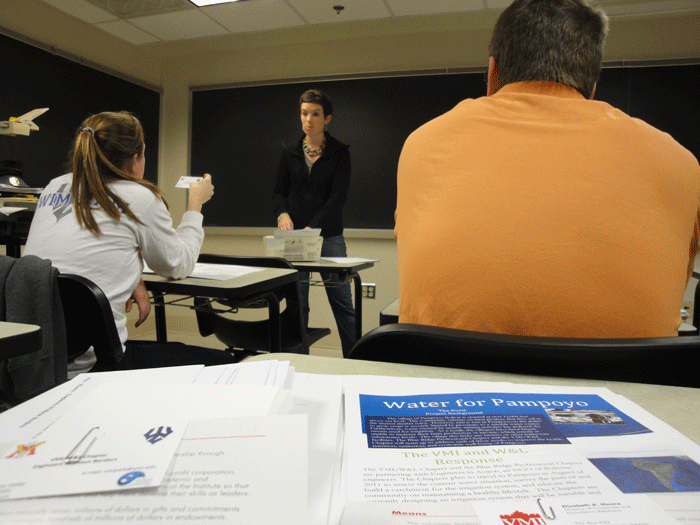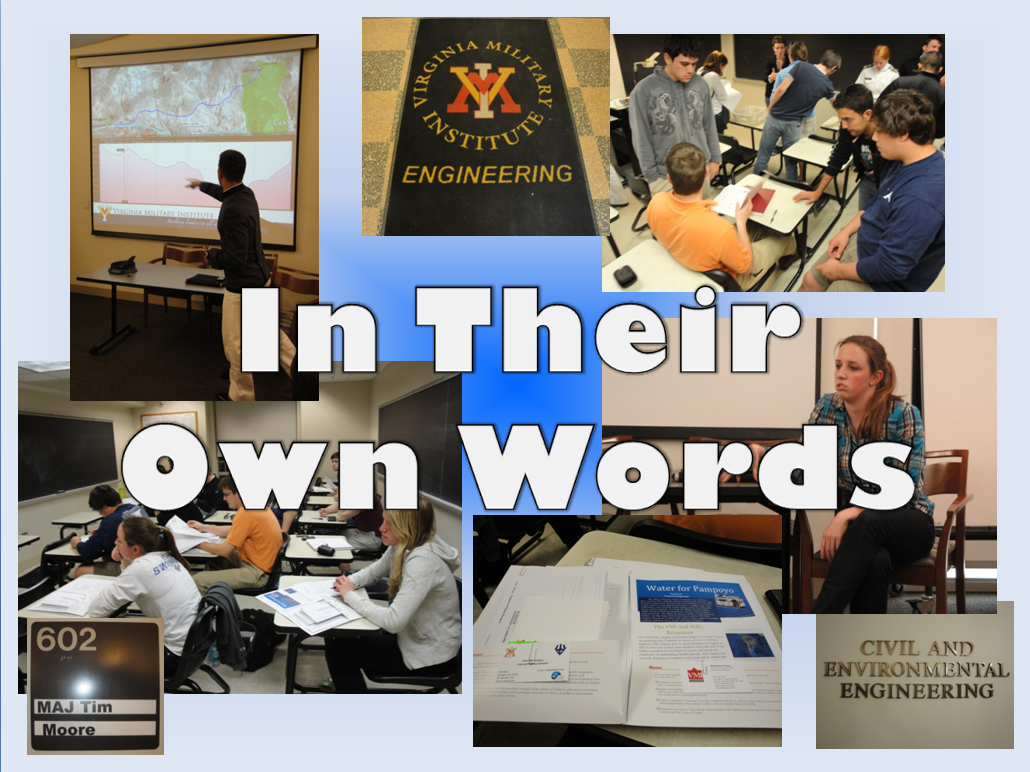 |
Students from VMI and W&L meet and discuss ways to raise money to pay for their humanitarian engineering project. Photo by Kelly Mae Ross. |
Water for Pampoyo
Students from neighboring campuses come together to help a small Bolivian village
April 13, 2011
Nearly seven people die every minute from water-related diseases worldwide, according to data from the World Health Organization. Most recently, a water-borne disease made news headlines because of the cholera outbreak in Haiti, which was perpetuated by the lack of access to clean drinking water in the country following the severe January 2010 earthquake. In the fight to help stop the spread of easily preventable yet devastating diseases, a new class of warrior has emerged—the engineer. Students and professors from Washington and Lee University and the Virginia Military Institute will be travelling to the small village of Pampoyo, Bolivia this summer to help the 70 families there secure their health and the future of their community. The students and professors will do this by working to bring clean water to the village. Dana Fredericks, a current W&L junior majoring in chemistry-engineering, attended a lecture last term about the natural disaster that recently occurred in Haiti, and it was there that she met Major Tim Moore, assistant professor of civil engineering at VMI. Moore told Fredericks about an organization called Engineers Without Borders that works to improve the health and quality of life of people in underprivileged areas of the world through the construction of engineering projects. According to the Engineers Without Borders website, the projects that EWB groups plan and build provide “necessities such as clean water, power, sanitation and education.” Fredericks is now the founder and president of the W&L EWB group, which works in collaboration with the VMI EWB chapter. She said that she is excited about EWB because the group’s work is “beneficial to both the people of Bolivia and the students.” The W&L group will work in collaboration with the VMI chapter, the official chapter in the area. Moore is the adviser of the VMI chapter, and this is not the first time that he has been involved with this type of humanitarian work. How it all began “She was my tie to the country at that time,” said Moore, who made several return trips to Haiti to visit Lily while mentoring students who were building a well in a Haitian village through a group called Engineers Without Borders. Three years later, Moore and his wife completed the lengthy adoption process and were finally able to bring Lily home with them to the United States. But this was not the end of Moore’s ties to Haiti and to other impoverished countries of the world. Moore returned to VMI, his alma mater, this fall to accept a teaching position in the school’s engineering department. He decided that he wanted to help get local students involved in humanitarian projects similar to the one he had worked on in Haiti—he wanted to begin a VMI chapter of Engineers Without Borders. He thought, “Why not give [these students] a taste of what it’s like to be citizen soldiers?” A multiphase project “That bridge [between healthcare and engineering] is there, but it really hasn’t been securely built yet,” he said. Those involved with the VMI chapter of Engineers Without Borders have been assigned a specific village and a specific project on which to target their efforts. The VMI chapter is collaborating with the Blue Ridge professional chapter of EWB to design a multi-phase water delivery system for the small Bolivian village of Pampoyo. “A remote, isolated village—you’re not going to find much opportunity there,” said Carrie Wortham, a junior biology student at VMI and president of the VMI EWB chapter. “So what we’re doing will hopefully encourage the younger generations to stick around,” she said. Clean water is needed in the village because the water source that the villagers currently use has been polluted by runoff from old mines located upstream.
The clean water will be used for crop irrigation, and those working on the project hope the boost in supply will lead to a 400 percent increase in arable land in Pampoyo. More land would allow local farmers to grow more crops and move beyond just subsistence farming, Moore said. The extra crops not needed to feed local families could be sold for a profit, he said. The water delivery system for Pampoyo will be built in multiple phases. The first phase is the building of the water catchment system that will capture and divert water from the stream that serves as the village’s water supply. The water will be diverted before it reaches the area where it is currently being contaminated. Phase two of the project will be the laying of over three miles of pipe that will transport the now-clean water to the fields of the village farmers. Members of the village will be aiding in the construction of the water catchment and irrigation systems. According to the EWB-USA website, all of the organization’s chapters form partnerships with the people of the villages in which they work, instead of just telling the villagers what they need. “We need to be like project managers,” said Moore. “I’m excited just to get to know these people,” said Wortham. “As a biology major, I don’t think I will be doing the engineering surveying piece, but hopefully I will be in the village doing more … like a health assessment.” While those involved with the project are eager to help, there are obstacles that stand between them and their goal of bringing clean water to the people of Pampoyo. Hurdles in the way The group has already raised about $16,000 said Elizabeth Moore, the VMI foundation’s director of corporate and foundation relations and the wife of Major Moore. Also, according to the W&L website, Fredericks was recently awarded a Johnson Opportunity Grant from the school that will help ease some of this cost burden. Fundraising is but one of the challenges that faces the two groups. Also of concern is the sustainability of the project. While the construction of the catchment and irrigation systems is occurring, other members of the group will be working with villagers to teach them about various aspects of health related to clean water. “A huge part of the project also is interfacing with the communities and understanding how what the engineering contraption’s going to do is going to impact them in other ways,” said Jonathan Erickson, assistant professor of physics and engineering at W&L and the advisor to the W&L EWB group. According to the March 2011 issue of the magazine Mechanical Engineering, “Even something as basic as a latrine needs a careful introduction.” Fredericks has been in contact with students interested in poverty and human capability studies at W&L to see if they would like to help with this aspect of the group’s work in Bolivia. Education is a large component of each EWB project. Moore said that EWB groups don’t do the villages that they work with any favors by building them a foreign contraption and then leaving. Yet another challenge that the VMI and W&L students will face is the physical environment of Pampoyo. The tiny, less than 200-person village lies about 13,000 feet above sea level and some students may have trouble adjusting to the high altitude. “It’s serious elevation,” said Erickson. “I grew up in Colorado and grew up in sort of a family of mountaineers so I’ve been up to high elevation a couple of times but it definitely burns the lungs the first couple of days, there’s no doubt about it. Your body’s getting used to it. It’s hard laboring up there,” he said. Erickson said that time has been built into the students’ summer travel schedule that will give them a few days to begin adjusting to the altitude before they actually begin laboring. But while the students, professors and other engineers may be able to adjust to the altitude, another challenge they will face is the language. Some of the students know basic or intermediate Spanish and Erickson is “proficient but not fluent,” but engineering vocabulary is not the sort of thing that most intermediate Spanish students are taught in American schools. “I mean, I can order a taco or something like that,” said Matt Brock, a junior engineering student at VMI and the vice president of the VMI EWB chapter. “But… we’re going to have translators there.” A more current challenge that the members of the chapter are facing is the recruitment of other, preferably younger students. Wortham, Fredericks and Brock are all juniors, and they’ve already started looking for young students to come in and keep EWB alive after the three of them graduate. They’ve held several recruitment meetings on both campuses and they’ve started getting feedback from some interested students. Benefits at home and abroad “It bridges gaps that have existed for years between VMI and W&L,” said Moore. Members of the chapter and the group said that there have been no problems, other than scheduling conflicts, when it comes to inter-campus collaboration. Brock said he thinks it’s great that W&L students are getting involved with the Pampoyo project and that he appreciates the different way of thinking he says he believes W&L students have. “They have a different outlook on things and that’s really nice,” he said. “And another thing, it’s just cool to be able to talk with somebody that’s not wearing one of these things, you know,” Brock said as he pointed to the VMI patch on his jacket. “It’s a little outside contact for once."
|
| Regional events calendar |
Local government websites: |
Produced by Washington and Lee digital journalism students.
![]()





